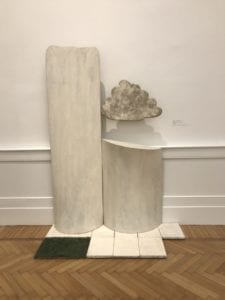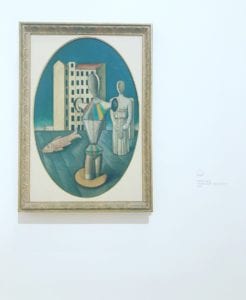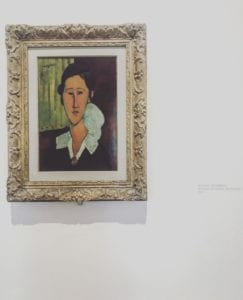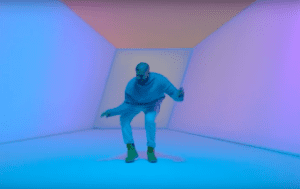Since October 11, 2016, La Galleria Nazionale d’Arte Moderna in Rome opened its Time is Out of Joint exhibition, which sparked the interest of many art lovers in Europe and around the world. On a recent trip to Rome, we had to check it out. The exhibition, named after a phrase in Hamlet by Shakespeare, provides a discourse about time, its permanence, impermanence, and ever-changing state. It was organized by the gallery’s new director, Cristiana Collu, with the idea in mind to challenge and renovate the gallery’s space which allows new interpretations of the art than ever before.
Taking place in a Neo-classical style building, the modern and contemporary art that fills the building’s large exhibition is shocking at first glance. Even before taking a step inside, you can see how provocative it is, with unfinished and displaced lion sculptures, as well as writing on the steps which lead into the building that resembles classical architecture from antiquity. Noticing these features before seeing the exhibition is a great way to see how the gallery, after its renovation, planned and organized every detail of the exhibition in relation to time and temporal distortion.

Stepping inside, everything is white. White walls, large white ceilings, white marble sculptures. This is where things begin to change. Walking straight into the entrance to the exhibition are model homes, a large Cinderella-like dress, paintings on the walls, and sculptures that interact with each other. You begin to feel you are in a distorted sense of time, with art from the late 19th century, art from the mid 20th century, and recent 21st-century art that do not seem to belong together. You begin to think that everything was placed with no order nor function as if there was no plan. In fact, on the contrary. Everything has some relation; whether it be with the artists, the subject matter, the movements the art was produced in, or just by aesthetics.
In this exhibition, there are works by Gustav Klimt, Monet, Amedeo Modigliani, Joan Miro, Michelangelo Pistoletto, Lucio Fontana, de Chirico, and much more. It is a modern art lover’s dream. Taking up the entirety of the large building, the exhibition includes paintings, sculptures, interactive pieces, ceramics, videos, and pieces solely with sound. In each room, there are artworks with different mediums to make you think about the relation of the pieces together, and it is difficult as most relations are not obvious. In a place where art from different time periods and art movements are put together in one space, they come together in a blank room where the walls and décor have no predispositions on or empowerment over the art. This allows the audience to think about why they are all put together.


Our favorite room in the exhibition was the room almost completely full of de Chirico’s work. Giorgio de Chirico was an Italian, Greek-born artist who jumpstarted the Metaphysical Art movement alongside former Italian Futurist Carlo Carrà (whose work is also in this exhibition). This movement influenced Surrealists as it introduced different uses of time, space, dream-like sequences, memory, and themes of going beyond the physical realm of reality. De Chirico’s use of geometry, ancient Roman subject matter, along with bright colors and his memories draw us into his work. There were later paintings alongside his earlier works that provide nice contrasts and discourses in the room.


Against the white walls, these pieces all stand out in one way or another, be it color, scale, the frames, or having to walk around a piece that was placed in a location to look at every angle and interact with it. This allows the visitor to feel misplaced and uncomfortable so that they have to move around a piece in the center of the floor. What we find great and admirable about this exhibition was the interaction between the art and the audience, not by touching, but by movement, sounds, or provocative visuals to make them stop and think. What could be different are the wall labels, seeing as they only included the artist, object title, and date, and not the material used or where it came from.
It is a bit shocking not have seen any English on the labels, seeing as the title of the exhibition is in English, especially being in a large, well-known national art gallery where nowadays even the tiniest international galleries and museums are starting to use English or other languages more often than not. With this action, along with the purposeful placement of the pieces, as well as the lighting and movement in the space, the director attempted to make it necessary for each visitor to have a discourse about the exhibition in every possible form, which we believe was quite successful.


La Galleria Nazionale d’Arte Moderna is open from Tuesday to Sunday: 8.30 – 19.30 with final entry 45 minutes before closing. You can purchase tickets here.



